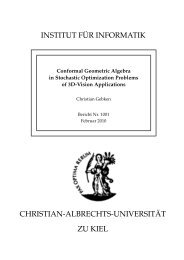Curry: An Integrated Functional Logic Language
Curry: An Integrated Functional Logic Language
Curry: An Integrated Functional Logic Language
You also want an ePaper? Increase the reach of your titles
YUMPU automatically turns print PDFs into web optimized ePapers that Google loves.
import stack<br />
imports all entities exported by the module stack, whereas the declaration<br />
import family(father, grandfather)<br />
imports only the entities father and grandfather from the module family, provided that they<br />
are exported by family. Similarly to export declarations, a datatype name t in an import list<br />
imports only the datatype without its constructors whereas the form t(..) imports the datatype<br />
together with all its constructors (provided that they are also exported).<br />
The names of all imported entities are accessible in the current module, i.e., they are equivalent<br />
to top-level declarations, provided that their names are not in conflict with other names. For<br />
instance, if a function f is imported from module m but the current module contains a top-level<br />
declaration for f (which is thus directly accessible in the current module), the imported function is<br />
not accessible (without qualification). Similarly, if two identical names are imported from different<br />
modules and denote different entities, none of these entities is accessible (without qualification). It<br />
is possible to refer to such imported but not directly accessible names by prefixing them with the<br />
module identifier (qualification). For instance, consider the module m1 defined by<br />
module m1 where<br />
f :: Int -> Int<br />
...<br />
and the module m2 defined by<br />
module m2 where<br />
f :: Int -> Int<br />
...<br />
together with the main module<br />
module main where<br />
import m1<br />
import m2<br />
...<br />
Then the names of the imported functions f are not directly accessible in the main module but one<br />
can refer to the corresponding imported entities by the qualified identifiers m1.f or m2.f.<br />
<strong>An</strong>other method to resolve name conflicts between imported entities is the qualification of an<br />
imported module. If we change the main module to<br />
module main where<br />
import qualified m1<br />
import m2<br />
...<br />
then the name f refers to the entity m2.f since all entities imported from m1 are only accessible by<br />
qualification like m1.f.<br />
A further method to avoid name conflicts is the hiding of imported entities. Consider the<br />
following definition:<br />
25
















